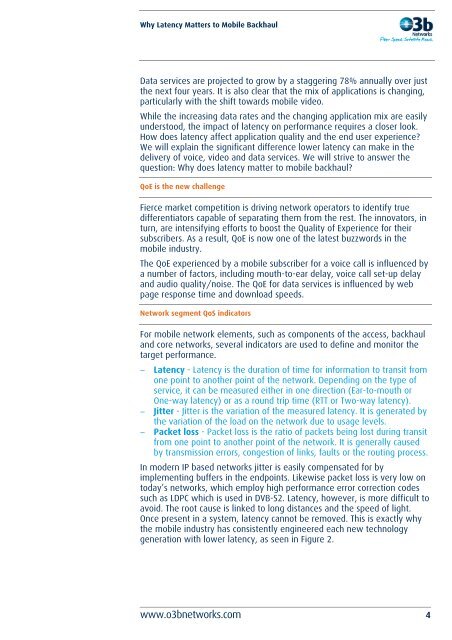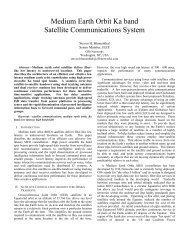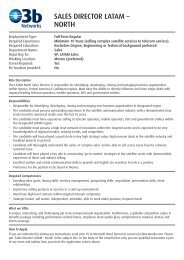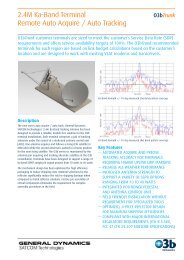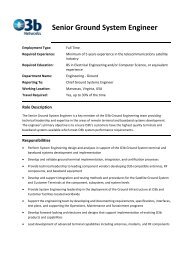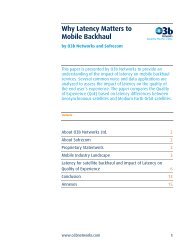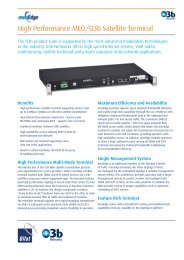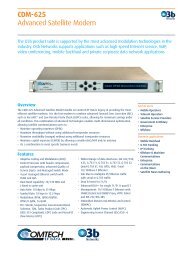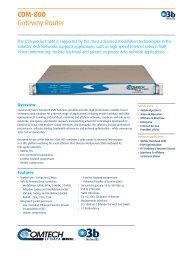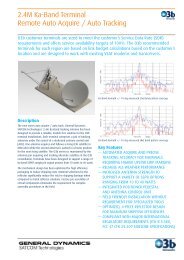Why Latency Matters to Mobile Backhaul - O3b Networks
Why Latency Matters to Mobile Backhaul - O3b Networks
Why Latency Matters to Mobile Backhaul - O3b Networks
- No tags were found...
You also want an ePaper? Increase the reach of your titles
YUMPU automatically turns print PDFs into web optimized ePapers that Google loves.
<strong>Why</strong> <strong>Latency</strong> <strong>Matters</strong> <strong>to</strong> <strong>Mobile</strong> <strong>Backhaul</strong>Data services are projected <strong>to</strong> grow by a staggering 78% annually over justthe next four years. It is also clear that the mix of applications is changing,particularly with the shift <strong>to</strong>wards mobile video.While the increasing data rates and the changing application mix are easilyunders<strong>to</strong>od, the impact of latency on performance requires a closer look.How does latency affect application quality and the end user experience?We will explain the significant difference lower latency can make in thedelivery of voice, video and data services. We will strive <strong>to</strong> answer thequestion: <strong>Why</strong> does latency matter <strong>to</strong> mobile backhaul?QoE is the new challengeFierce market competition is driving network opera<strong>to</strong>rs <strong>to</strong> identify truedifferentia<strong>to</strong>rs capable of separating them from the rest. The innova<strong>to</strong>rs, inturn, are intensifying efforts <strong>to</strong> boost the Quality of Experience for theirsubscribers. As a result, QoE is now one of the latest buzzwords in themobile industry.The QoE experienced by a mobile subscriber for a voice call is influenced bya number of fac<strong>to</strong>rs, including mouth-<strong>to</strong>-ear delay, voice call set-up delayand audio quality/noise. The QoE for data services is influenced by webpage response time and download speeds.Network segment QoS indica<strong>to</strong>rsFor mobile network elements, such as components of the access, backhauland core networks, several indica<strong>to</strong>rs are used <strong>to</strong> define and moni<strong>to</strong>r thetarget performance.− <strong>Latency</strong> - <strong>Latency</strong> is the duration of time for information <strong>to</strong> transit fromone point <strong>to</strong> another point of the network. Depending on the type ofservice, it can be measured either in one direction (Ear-<strong>to</strong>-mouth orOne-way latency) or as a round trip time (RTT or Two-way latency).− Jitter - Jitter is the variation of the measured latency. It is generated bythe variation of the load on the network due <strong>to</strong> usage levels.− Packet loss - Packet loss is the ratio of packets being lost during transitfrom one point <strong>to</strong> another point of the network. It is generally causedby transmission errors, congestion of links, faults or the routing process.In modern IP based networks jitter is easily compensated for byimplementing buffers in the endpoints. Likewise packet loss is very low on<strong>to</strong>day’s networks, which employ high performance error correction codessuch as LDPC which is used in DVB-S2. <strong>Latency</strong>, however, is more difficult <strong>to</strong>avoid. The root cause is linked <strong>to</strong> long distances and the speed of light.Once present in a system, latency cannot be removed. This is exactly whythe mobile industry has consistently engineered each new technologygeneration with lower latency, as seen in Figure 2.www.o3bnetworks.com 4


